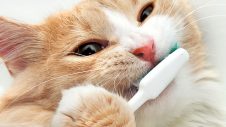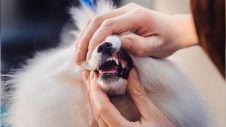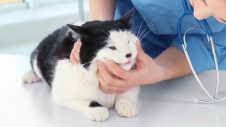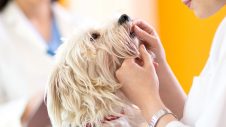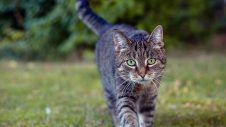 Smelly breath in our pets isn’t normal. Often, bad breath is a sign that your cat’s teeth are in poor health. Know the signs of dental disease and how to prevent tartar.
Smelly breath in our pets isn’t normal. Often, bad breath is a sign that your cat’s teeth are in poor health. Know the signs of dental disease and how to prevent tartar.One of the easiest ways to care for your cat’s teeth is to provide a varied diet consisting of both soft and dry food. ‘It’s important that cats are not solely on a wet food diet like tinned food or pouches. If cats only eat soft foods, they don’t use their teeth like they’re meant to,’ says Dr Tessa Jongejans from Greencross Vets Mortdale. ‘This results in plaque build-up which, over time, calcifies and turns into tartar. This causes gingivitis and eventually tooth loss and other problems.’
‘Cats don’t brush their teeth as humans do, so plaque can accumulate quite quickly,’ Dr Jongejans continues. ‘Dry foods scrape and clean the teeth. Chicken necks are also a good idea, but it’s not a suitable solution for everyone. Check with your vet first. Dental treats can also help to clean their teeth. Look for products that have the stamp of approval from the Veterinary Oral Health Council as these have been proven to reduce plaque and tartar.’
Brush their teeth
Brushing your feline’s teeth is a great way to remove plaque, but there are other factors to consider. ‘Make sure your cat is friendly enough to touch them around the mouth,’ says Dr Jongejans. ‘Use special toothpaste that is beef or chicken flavoured as your cat will see it as a reward. First, let them taste the toothpaste. Using a nice soft brush, gently rub over the teeth. Start slowly and work your way up to brushing their teeth.’
What dental problems occur in cats?
‘Tartar buildup and gingivitis are the most common dental problems. Cats can also get Feline Oral Resorptive Lesions (FORLS), which is a decay of the tooth (similar to a cavity in humans). You can’t see it on the outside of their tooth, but it is very painful. It can cause a cat to stop eating, to be sore in the mouth and drool, and often happens in several spots. Outside cats are also prone to having fractured teeth from biting on hard things,’ says Dr Jongejans.
Signs of dental problems
Cat owners should watch for excessive drooling, pawing at the mouth, bad breath or decreased appetite. Another sign could be a reluctance to have dry foods and only wanting soft food or licking up food as opposed to chewing it. The gums can look red, inflamed, even and bleed. Bad breath and yellowish-brown tartar on teeth are other signs your cat might need to see a vet.
What to expect when visiting the vet?
Dr Jongejans says, ‘When visiting the vet, we would check the mouth, check the state of the teeth and gums and check for any ulcers as far as the cat will let us. We talk to the owners and share advice on how to manage their cat’s teeth at home, or how to clean their teeth or change their diet. If it’s something that might need a dental scale and polish or tooth extraction, we would provide an estimate for the surgery and any specific recommendations for that cat and go from there.’
Dental tip
Give your cat food that requires mechanical cleaning such as dry food, biscuits, chicken necks or dental treats that have the seal of approval. These products work best if your cat’s teeth are clean and any tartar buildup has been removed. Some products come in liquid or powder form and can be added to water or food bowls.
Book your cat into your local Greencross Vets for a dental health check today.

 Greencross Vets
Greencross Vets 